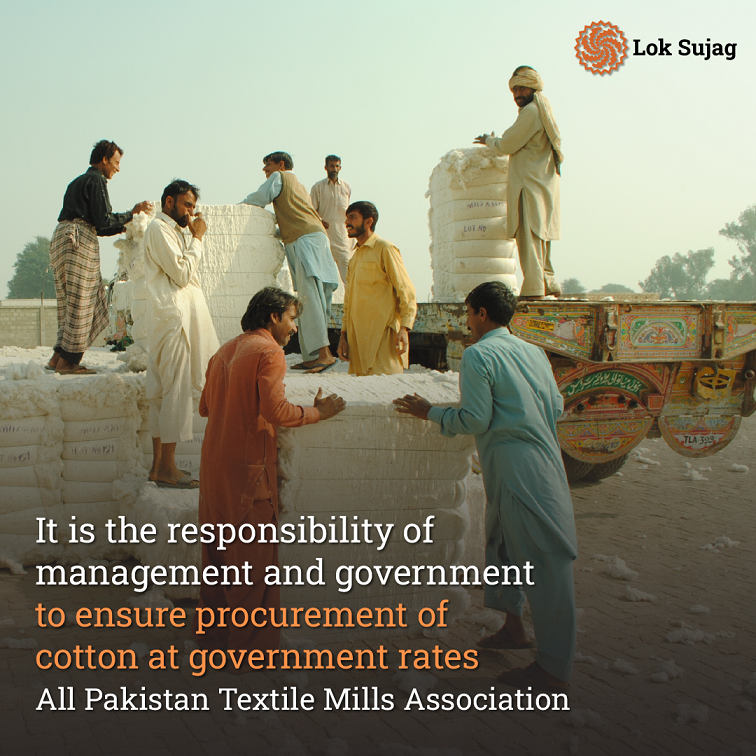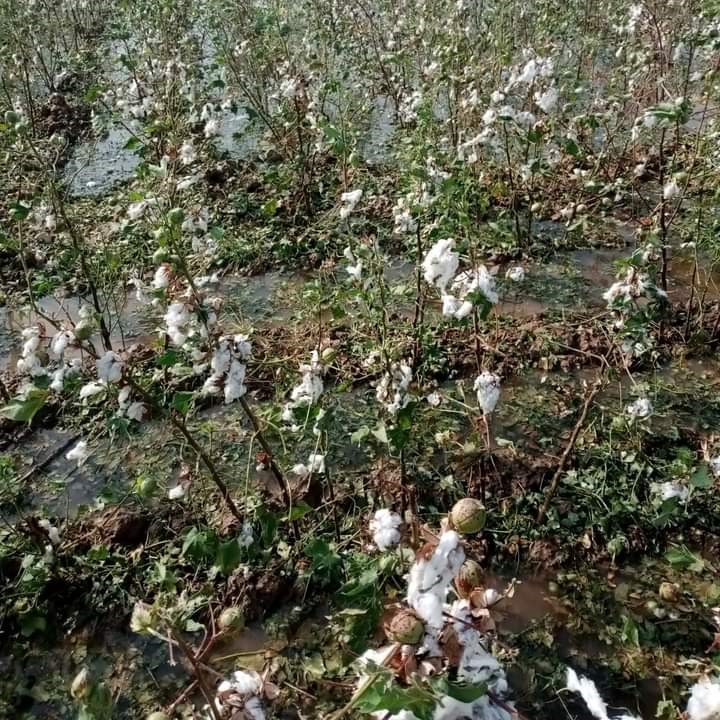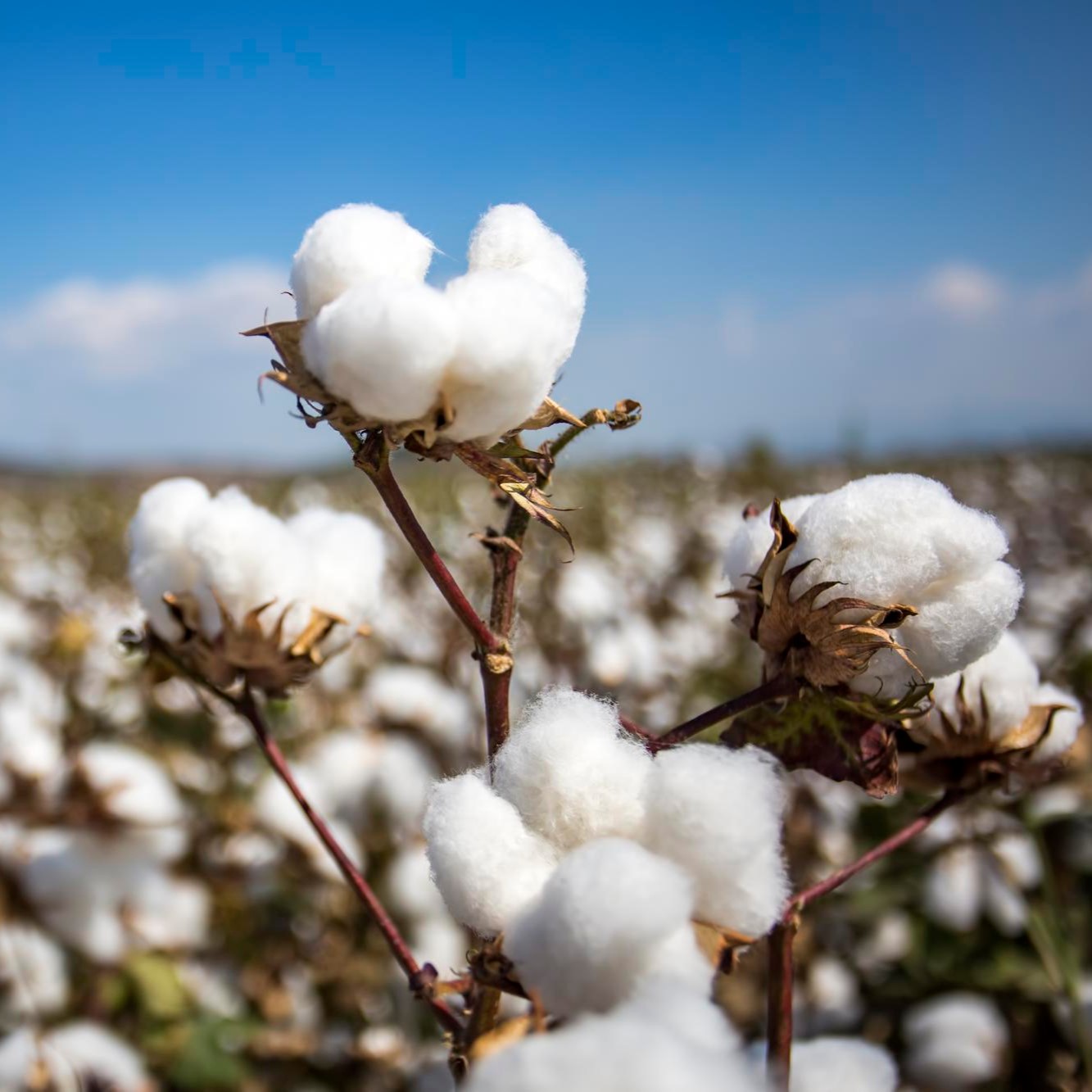Muhammad Ashraf Dhadi belongs to Donga Bonga town of Bahawalnagar district. He is a significant cotton cultivator. Last year, he cultivated this crop on one hundred and ten acres. However, he is concerned about selling his produce because its prices have significantly decreased.
Ashraf says that the per maund price of cotton has decreased twice in the last few months. Now, the cotton prices in the market have fallen to 6800 rupees. This is Rs 1700 less than the Rs 8500 announced by the government.
He says that if he sells his crops at the current market rate, he will suffer because the prices of diesel, fertilisers, sprays, and other agricultural inputs have gone up a lot this time.
As Ashraf has the resources, he has stocked about 250 maunds of cotton from the last harvest. Now, he wants to sell it when its monthly rate reaches the minimum official price of Rs 8500.

He also goes around the market periodically to know the rate. In this regard, he also went to the market in his town, Donga Bonga, on November 1, where, according to him, the traders told him that the dollar's value had become very low. Therefore, it is running short in the cotton market as well.
"Why has the dollar depreciation only reduced cotton prices but not the prices of agricultural inputs such as fertilisers, sprays, and diesel?"
He maintains that these are all fabrications a mafia has entered the market for the last few years, which wants to extract capital by harming the farmers.
According to the government's claims, cotton has been cultivated on more than 4.8 million acres of land in Pakistan this year, which is more than the previous five years. The government has estimated that this year, Pakistan will be able to get 1.2 million bales from this cultivated area.

The three divisions of South Punjab, comprising Multan, Bahawalpur, and Dera Ghazi Khan, account for approximately 85 per cent of the total cultivated area in Punjab.
Currently, almost all the cotton farmers are in the same situation as Muhammad Ashraf.
Farmers who have the resources are holding back their produce for a while, but the small landowners, who have to bear the expenses of cultivating the wheat crop from the profits of cotton, are in dire straits and forced to sell their produce.
Regarding the production of cotton in Pakistan, the supervising Federal Minister of Industry and Trade, Gohar Ijaz, told the media a few days ago that Pakistan is going to achieve record production of this crop after a gap of eleven years.
According to him, by October 1, 2023, 5 million bales of cotton had reached the factories, which is more than the figure of 4.9 million cotton bales for the whole year last year.
According to a report published on the website of the Pakistan Cotton Yarns Association, 6 million bales had arrived at the factories by October 16.

Similarly, according to the data released by the association on October 18, currently, 734 thousand 737 bales of cotton are present in the warehouses of cotton producers, estimated to be worth about 75 billion rupees.
However, Trading Corporation Pakistan is not interested in its purchase. According to the association's position, the result was that the buyers also started buying cotton wool from the farmers at reduced prices.
Wasim Akram runs a cotton ginning factory in Jalalpur, a suburb of Multan. He says that the reason for not buying cotton at the official rate is its low quality.
“The September rains and moisture have badly affected cotton production. Even for the textile sector, it is not possible to purchase at Rs 8,500 fixed by the government. Because now electricity and freight costs have increased manifold.”
He says that currently, the interest rate of the banks is very high, due to which the factory owners are deprived of bank financing as there is no savings in sight.

Chaudhry Waheed, chairman of the Pakistan Cotton Ginners Association, also confirms this and says that at present, there are about seven and a half million bales of cotton in the ginning factories. "And we have no more purchasing power".
According to him, the price of cotton at the beginning of the season was 20 thousand rupees per maund, which today has reached 14 to 15 thousand rupees per maund, and at this price, the cotton factories and the farmers are both suffering.
Ghulam Abbas, a significant buyer of cotton from farmers in Multan, also attributes the downturn in the Mughal cotton market to the Trading Corporation of Pakistan (TCP) not starting purchases.
They say the government had promised to buy 1 million cotton bales from ginning factories and mills, but they have not yet started the purchase, causing instability in the market.
In this regard, Deputy Director GODAN Trading Corporation of Pakistan Mian Asad Maqbool Mudal told Lok Sajag that TCP has completed all its preparations for cotton procurement. As soon as orders are received from the Ministry to complete the necessary formal legal proceedings, the cotton procurement process will be started soon, and 10 lakh cotton bales will be purchased at official rates.

It should be noted that this government institution did not purchase cotton last year, which is also confirmed by the Deputy Director.
According to sources, this time, the purpose of the purchase of this institution was to stabilise the market, and due to the government purchase, the farmers must get the minimum support price.
According to the farmers, till November 1 this year, about 80 per cent of the harvesting process has been completed, and so far, 6 million bales have reached the Jenners factories. Therefore, it is feared that this time, too, the production will be up to 8 million bales.
Farmers Muhammad Ismail and Muhammad Ashraf say that this year they have planted cotton in more areas than before, but after the rains in August and September, whitefly attacks have affected it greatly, reducing production.

Coordinator of the Federation of Chambers of Commerce and Industry of Pakistan (FPCCI) Talat Sohail says that in the same way the government has set the rate of cotton this time, it should also set the rate of cotton because the problems that are coming up this time are due to not fixing the cotton rate.
He says that when the cotton reaches the Genners factories, they now have to bear huge expenses in terms of electricity, labour, and freight to separate the cotton from the fibres. So they prefer to buy less than to be at a loss.
"Just as the government sets the rate of wheat and its by-product flour, then what is the problem in setting the rates of cotton and cotton?"
Also Read

Farmers in Mianwali grapple with hailstorm’s devastation on cotton crops
They criticise the Trading Corporation of Pakistan for not yet starting procurement. He says that according to the government, this year, the country has a claim of 1 crore 2 million bales of production. According to this estimate, the Trading Corporation of Pakistan should have started the purchase of cotton practically two months ago.
Talat Sohail says that future cotton cultivation is subject to compensation for the current crop. He termed the impact of the dollar rate on the cotton market as fabricated propaganda, saying that last year, the dollar was at 280 rupees, and cotton was being bought at 10,000 rupees. Now the dollar is at 275 rupees, so why can't the purchase of cotton be 8500 rupees?
He said that the government should immediately intervene in the market and start buying at the rate announced by the government.
General Secretary All Pakistan Textile Mills Association (APTAMA) Asif Inam told Lok Sajag that it is the responsibility of the administration and the government to ensure procurement at the government rate. Textiles is buying as per its requirement and also looking to buy more in the coming days. The country's textile requirement ranges from 1.2 million to 1.4 million bales, so they are keen to purchase more.
"What is going on in the market and improving it is the government's responsibility. It should adopt a better mechanism so that the farmers do not suffer."
Published on 3 Nov 2023




















